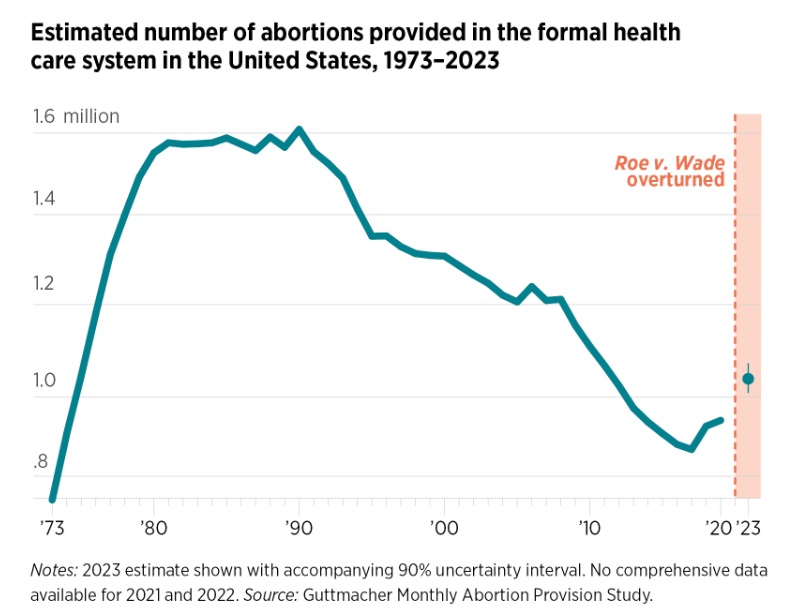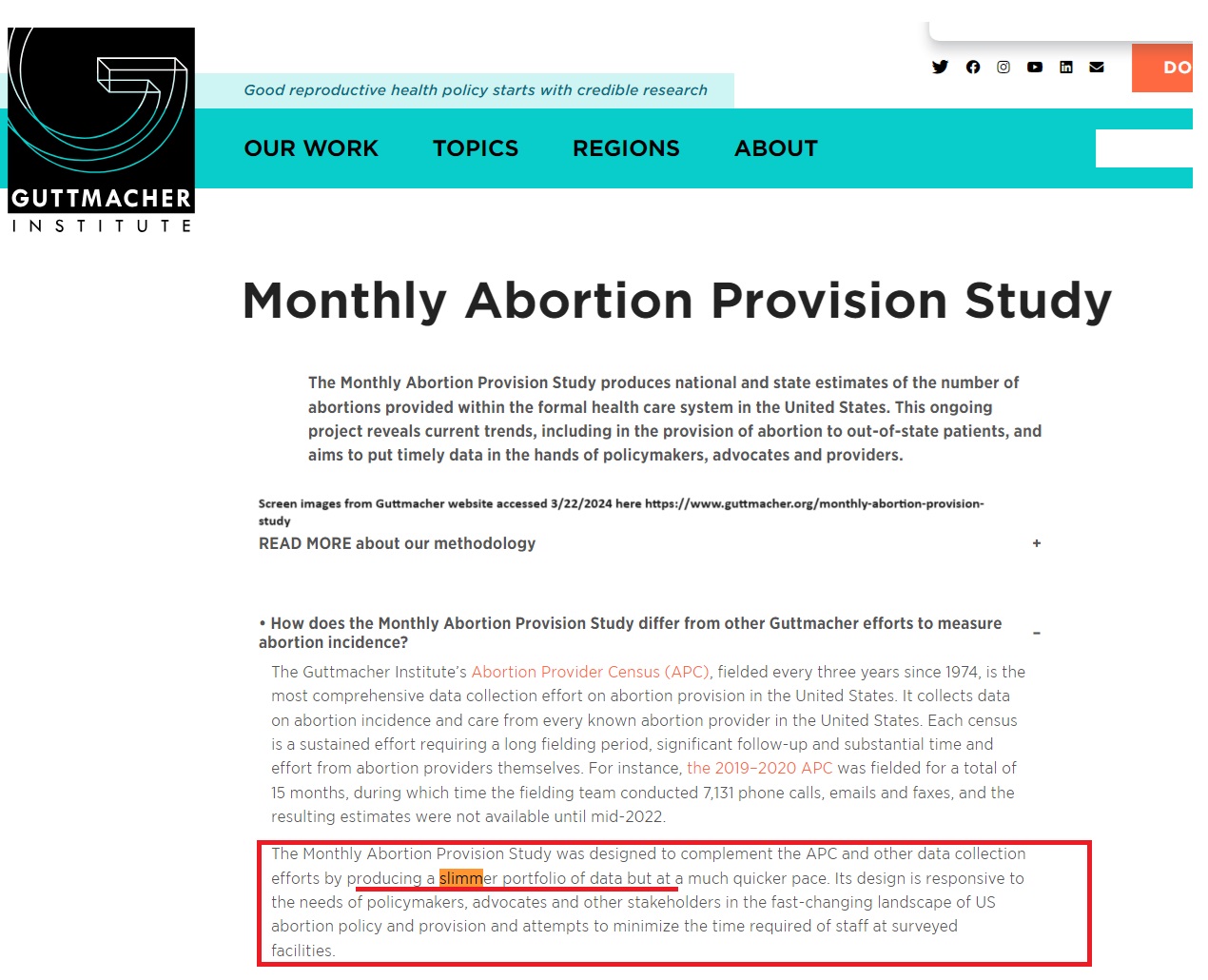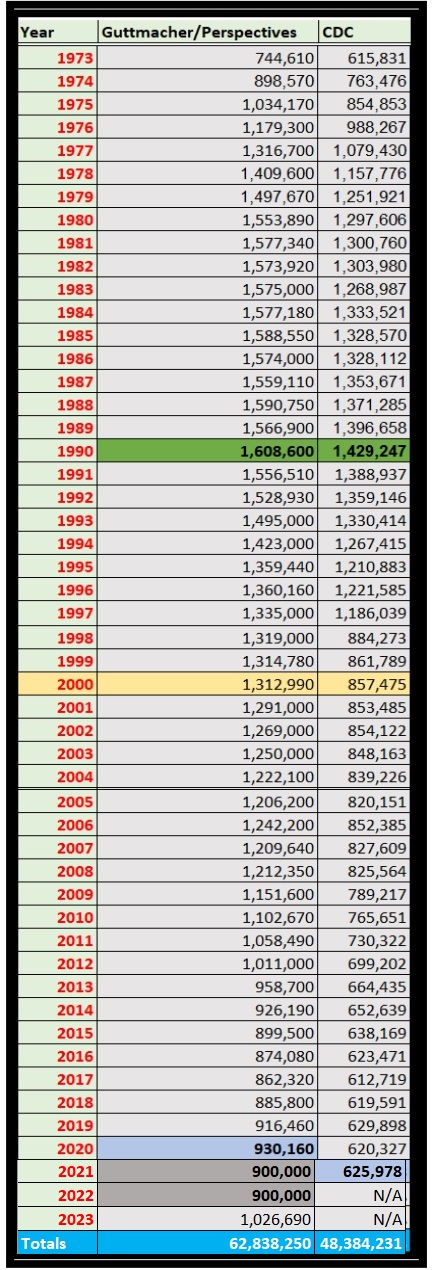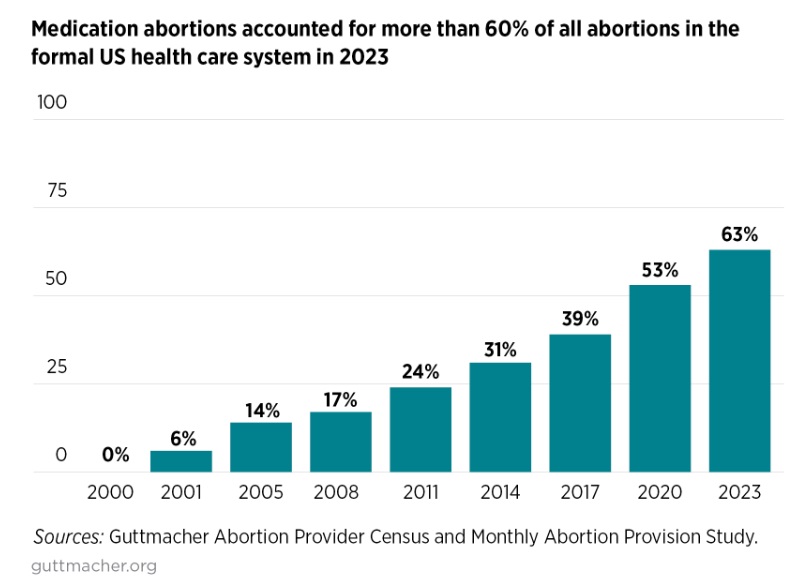UPDATE, 6/17/24: In May of 2024, the Guttmacher Institute updated their total abortion number for the year 2023, writing that, “Monthly Abortion Provision Study show that an estimated 1,037,000 abortions occurred in the formal health care system in 2023.”
This updated figure reveals that 2,841 abortions daily in the U.S. — 118 abortions per hour, nearly 2 per minute, and one abortion every 30 seconds.
“This represents a rate of 15.9 abortions per 1,000 women of reproductive age,* and is a 11% increase since 2020 [930,160 recorded in 2020], the last year for which comprehensive estimates are available. It is also the highest number and rate measured in the United States in over a decade,” the former “special affiliate” of Planned Parenthood reported in May.
Abortions have reached the highest reported number in a decade, as abortion pill use climbed to 63% of the “estimated 1,026,690 abortions [which] occurred in the formal health care system in 2023,” according to new data just released by the Guttmacher Institute. This equates to 642,700 chemical (abortion pill) abortions that year — 53,558 monthly, 1,761 daily, 73 hourly, and one every 49 seconds.
Guttmacher was once the research arm and “special affiliate” of Planned Parenthood and remains heavily in favor of abortion.
The 1,026,690 published abortion total for 2023 is slightly lower than the 1,054,000 abortions previously estimated by Live Action News for that same year; however, the numbers are still staggering, with approximately 63 million preborn lives estimated to have been ended by abortion since 1973, the year Roe v. Wade was decided by the U.S. Supreme Court.
Current statistics show 2,813 abortions daily in the U.S. — 117 abortions per hour, 1.9 per minute, and one every 31 seconds.

2023 Guttmacher abortion graph
Guttmacher Data Based on “Slimmer Portfolio”
The latest abortion totals are based on Guttmacher’s Monthly Abortion Provision Study. which the pro-abortion group acknowledged was a “slimmer portfolio of data.”
So, what changed?
In past reports, Guttmacher methodology relied on the “Institute’s Abortion Provider Census (APC), fielded every three years since 1974″ and described as “the most comprehensive data collection effort on abortion provision in the United States,” because Guttmacher claimed “Each census is a sustained effort requiring a long fielding period, significant follow-up and substantial time and effort from abortion providers themselves.”
- According to previously published methodology for abortion totals in 2020, abortion data released by Guttmacher came from 7131 phone calls, e-mails, and faxes sent to abortion providers, with only a small percentage of estimation.
- Study authors of the 2020 data claimed that “84% of abortions that we counted were based on information obtained from health care facilities” and “an additional 4% of abortions from state health department data and we estimated the remaining 12% of abortions.”
Then, in late 2023, after nearly 50 years of using the same methodology, Guttmacher changed this methodology and began publishing monthly abortion estimates.
Guttmacher described this new methodology as less reliable than what had been previously used, writing that “The Monthly Abortion Provision Study was designed to complement the APC and other data collection efforts by producing a slimmer portfolio of data but at a much quicker pace. Its design is responsive to the needs of policymakers, advocates and other stakeholders in the fast-changing landscape of US abortion policy and provision and attempts to minimize the time required of staff at surveyed facilities.” (emphasis added)

Monthly Abortion Reporting Guttmacher “Slimmer portfolio” methodology
“The study’s estimates are generated by a statistical model that combines data from samples of providers with historical data on the caseload of every US provider. As more data are collected each month, estimates for past months become more precise. Each estimate is expressed as an uncertainty interval, which quantifies our confidence that the true value falls within a particular range,” Guttmacher also wrote.
Abortions Ticked Upwards Prior to Dobbs
Guttmacher has claimed a 10.38% percent increase over the course of three years — from 930,160 reported in 2020 to 1,026,690 reported in 2023.
But even prior to the demise of Roe v. Wade, abortion numbers were ticking upward.
- 2017 (862,320)/2018 (885,800) = 2.72% percent increase from 2017 to 2018.
- 2018 (885,800)/ 2019 (916,460) = 3.46% percent increase from 2018 to 2019.
- 2019 (916,460)/ 2020 (930,160) = 1.49% percent increase from 2019 to 2020.
Using just published abortion totals for years 2017-2020, Live Action News has calculated an average annual increase of 2.56% each year taking place prior to the Dobbs decision.
“The number of abortions in the United States peaked in 1990, at 1.6 million. Over nearly 30 years, they experienced a sustained decline, falling to 885,000 in 2017. In 2019 and 2020, however, this long-term trend started to reverse, with the number of abortions rising to 930,160 in 2020, marking an 8% increase from 2017…. While there are no comprehensive estimates for the next several years, partial data from the Centers for Disease Control and Prevention suggest that this increase continued at least into 2021,” Guttmacher wrote.
“Our estimated 2023 numbers represent a substantial increase even in this historical context; the last time there were over a million abortions provided in the formal health care system in the United States was in 2012,” they added.
Why the Increases?
Guttmacher has claimed the abortion increases were largely due to:
- Abortion travel after the Dobbs decision reversed Roe v. Wade and allowed life-affirming protections in multiple states.
- Increased use of ‘telemedicine’ abortion, which expanded the dispensing of the abortion pill under the Biden Administration.
- Increased abortion funding put in place due to the enactment of protections for the preborn in several states.
As The Economist noted in a recent article, “… a significant part of America’s total growth in abortions is the result of increases among residents of abortion-supporting states. In California, locals had an estimated 21,470 more abortions in 2023 compared with 2020 (accounting for 88% of the state’s increase), in Illinois they had 12,350 more (32% of the increase) and in New York 20,460 (97%). Overall, in states without bans, over half of the rise was down to locals having more abortions. This growth is likely to be, at least to some extent, the result of efforts to improve access in such states.” (emphases added)
Those abortion-incentivizing efforts include things like increased taxpayer funding for abortions, which has long been known to increase the abortion rate. The Biden Administration’s new budget proposal, if passed, is sure to increase abortions as well, due to its removal of provisions preventing most taxpayer-funded abortions.
The Economist writes:
Illinois, New Mexico and New York have increased their Medicaid reimbursement rates for first- and second-trimester abortion procedures by more than 200%, according to forthcoming analysis by KFF, a health-research organisation. This means more clinics may now be willing to accept lower-income patients. In ten states health insurers are now required to cover abortion, up from six before Dobbs. California is one of a handful of states that has gone further still. It now requires health insurers to eliminate all out-of-pocket costs.
While the largest increases were among abortion-supporting states, Guttmacher says that “[a]lmost every state without a total ban [in other words, states allowing for abortions only up to a certain gestational age] saw an increase in the number of abortions provided, as compared to 2020,” later adding that “states without total bans experienced a 25% increase in abortions provided in 2023, as compared to 2020.”
“States bordering ban states had particularly large increases. In total, abortions in these states increased by 37% between 2020 and 2023, with particularly sharp increases in Illinois (38,010 more abortions than in 2020, or an increase of 72%), New Mexico (15,090 more abortions, an increase of 257%), Virginia (14,190, an increase of 76%) and North Carolina (12,970, or 41%),” Guttmacher wrote, claiming, “Much of the increase in these states was due to increased travel across state lines. Illinois, for example, provided abortion care to an estimated 25,660 more patients from out of state, accounting for 68% of its overall increase.”
In addition, Guttmacher claimed that “Even states not bordering ban states saw large increases—in total, abortion numbers increased in these states by 17% from 2020 to 2023.”
“The use of telehealth to provide medication abortion via mail increased considerably after the U.S. Food and Drug Administration lifted in-person dispensing requirements of mifepristone—one of the drugs most commonly used in medication abortion—during the pandemic. Telehealth now represents a substantial portion of abortion provision in states without abortion bans. Numerous providers, including virtual clinics, have adapted telehealth to meet patient needs, and the availability of telehealth may have increased access, particularly for people in rural areas or who otherwise may not have been able to travel to a clinic for care,” they also claimed.
While “the vast majority of patients pay out of pocket” for abortions, Guttmacher claimed that “Increased financial support post-Dobbs—particularly from abortion funds—was a critical source of funding for people in ban states and may have increased access for many people living in states without bans as well.” However, they noted that “It is unclear, however, whether this financial support will be sustainable over time.”
Guttmacher doesn’t speculate about the possibility that increased abortion pill sales could be partly due to stockpiling rather than women purchasing them to immediately end the life of a preborn baby.
As Live Action News has documented multiple times, Big Abortion is more than willing to market the drug as a “missed period” pill and to ship “advance provision” of the abortion pill in violation of the FDA safety standards that require prescribers of the drug to be able to properly date an actual pregnancy.
In 2022, Politico reported that “The FDA said health providers prescribing abortion medication to people who aren’t pregnant are acting without its authorization and that the practice is potentially dangerous for patients.”
Increased Abortion Numbers and Abortion Rate
Overall reported abortions increased by over ten percent (10.38%) from the 930,160 recorded in 2020 to an estimated 1,026,690 abortions reported in 2023. This is “the highest number and rate measured in the United States in over a decade,” Guttmacher claimed.
“New findings from the Monthly Abortion Provision Study show that an estimated 1,026,690 abortions occurred in the formal health care system in 2023, the first full calendar year after the US Supreme Court’s decision in Dobbs v. Jackson Women’s Health Organization overturned Roe v. Wade,” wrote the former Planned Parenthood “research affiliate.”
In 2020, Guttmacher recorded an abortion rate (abortions per 1,000 women aged 15–44) of 14.4 (a 7% increase from the 13.5 reported in 2017.)
By 2023, the abortion rate had again risen nearly 10% to 15.7, “the last year for which comprehensive estimates are available. It is also the highest number and rate measured in the United States in over a decade,” Guttmacher added.

Abortion stats 1973-2023 Guttmacher published numbers (1973-2020) and CDC (1973 -2021) updated March 24
“It is important to note that these annual estimates are almost certainly an undercount, as they include only those abortions obtained within the formal US health care system: at brick-and-mortar health facilities, such as clinics or doctor’s offices, and via telehealth and virtual providers,” Guttmacher also wrote (emphasis added).
There are no federal reporting requirements for any abortion statistics, or for abortion complications.
Increased Abortion Pill Use
In 2020, before Roe was overturned, Guttmacher recorded 930,160 abortions committed nationally, and its report noted, “There were 492,210 medication abortions in 2020, a 45% increase from 2017.”
The newly released data for 2023 reveals that abortion pill use increased nearly 31% (30.57%) from the 492,210 reported abortion in 2020, (53% of all abortions) to 642,700 abortion pills recorded by 2023 (63% of all abortions). To reiterate, this breaks down to 53,558 chemical (abortion pill) abortions each month, 1,761 each day, 73 each hour, and one every 49 seconds.
The research from Guttmacher’s Monthly Abortion Provision Study reiterated that its abortion pill counts don’t include those that “take place outside of the formal health care system” or the abortion pill that is “mailed to people in states with total abortion bans.”
“While there are no comprehensive data on the number of self-managed medication abortions in the United States, evidence suggests they have been increasing in the past several years. Therefore, the total count of medication abortions nationally is higher than our count of those offered within the formal health care system,” Guttmacher added.
“The number of US providers offering a telemedicine consultation—by video, phone call, text or online platform—and mailing abortion pills increased from 7% of all providers known to offer medication abortion in 2020 to 31% in 2022. Online-only clinics, after first appearing as a new type of abortion provider in 2021, accounted for 8% of all abortions provided within the formal health care system in the first six months of 2023,” Guttmacher wrote.

63% of abortions were abortion pills in 2023 (Image: Guttmacher Institute)
Alliance for Hippocratic Medicine (AHM) v. Food and Drug Administration (FDA), a case being heard before the United States Supreme Court this month, is challenging the legality of the FDA’s recent abortion pill expansion decisions.
AHM has claimed in its brief that abortion pill-related emergency room visits are estimated to be in the tens of thousands, based on published percentages for ER visits on the drug’s 2023 label which state that “2.9 to 4.6 percent of women who take abortion drugs end up in the emergency room.”
In addition, AHM claimed that the FDA’s medication guide acknowledges that as many as seven percent (7%) of women will need surgery after taking mifepristone ‘to stop bleeding’ or to complete the abortion.

Photo: Reddit user brazen 177 (10-week aborted baby by abortion pill)
Tragically, potential emergency room visits from abortion pill related complications in 2023 are even higher than what Live Action News had previously estimated.
- Estimating ER visits from the newly published abortion pill data for 2023, reveals that out of the 642,700 abortion pills recorded by Guttmacher, between 19K (18,638) to 30K (29,564) women who took abortion drugs may have potentially ended up in the emergency room in 2023.
- In addition, using the 2-7% figure off the medication guide, we estimate that between over 13K-45K of women who took the abortion pill in 2023 potentially required “a surgical procedure because the pregnancy did not completely pass from the uterus or to stop bleeding.”
Abortion insiders have suggested that women should lie and claim to be miscarrying naturally when they present to the emergency room with abortion pill complications. This dampens any chance that accurate numbers on abortion pill complications or deaths will be reported as such to authorities.
Editor’s Note, 4/2/24: This piece has been updated to detail Guttmacher methodology.
Editor’s Note, 6/13/24: This article has been updated for clarification.







